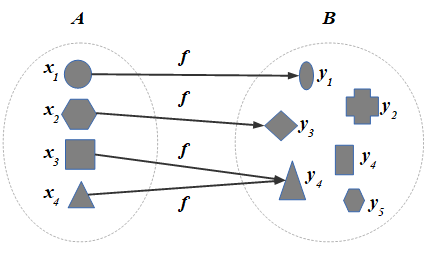(related to Chapter: Functions (Maps))
We want to visualize the introduced concepts on an example. The function $f:A\mapsto B$ maps the elements of the set $A$
into the elements of the set $B$. It is left-total, since all elements $x_1,x_2,x_3,x_4 of $A$ are mapped.
It is right-unique, since every $x\in A$ has only one value $f(x)\in B$.

As the figure shows, it is not necessary for a function to be right-total, since not all elements of $B$ have to be values of some elements of $A$: In the example, $y_2,y_4$ and $y_5$ are not contained in the image $f[A]$. In general, the image $f[A]$ is a proper subset of but not equal $B$ (in formulae $f[A]\subset B$ but $f[A]\neq B$).
Moreover, a function is in general, not left-unique, i.e. the values in $B$ have not to be different for different elements in $A$. For instance, $f(x_3)=f(x_4)$. For this reason, the fiber $f^{-1}(y_r)$ contains two elements $x_3,x_4\in A.$.
Caution: The fiber $f^{-1}$ is not a function, it is only a notation for a special set. There are other mathematical objects with the same notation. Usually, inverse functions and the function \(x\mapsto \frac1{f(x)}\) which we will learn about later, are also denoted by $f^{-1}$. You must be careful not to confuse these concepts.